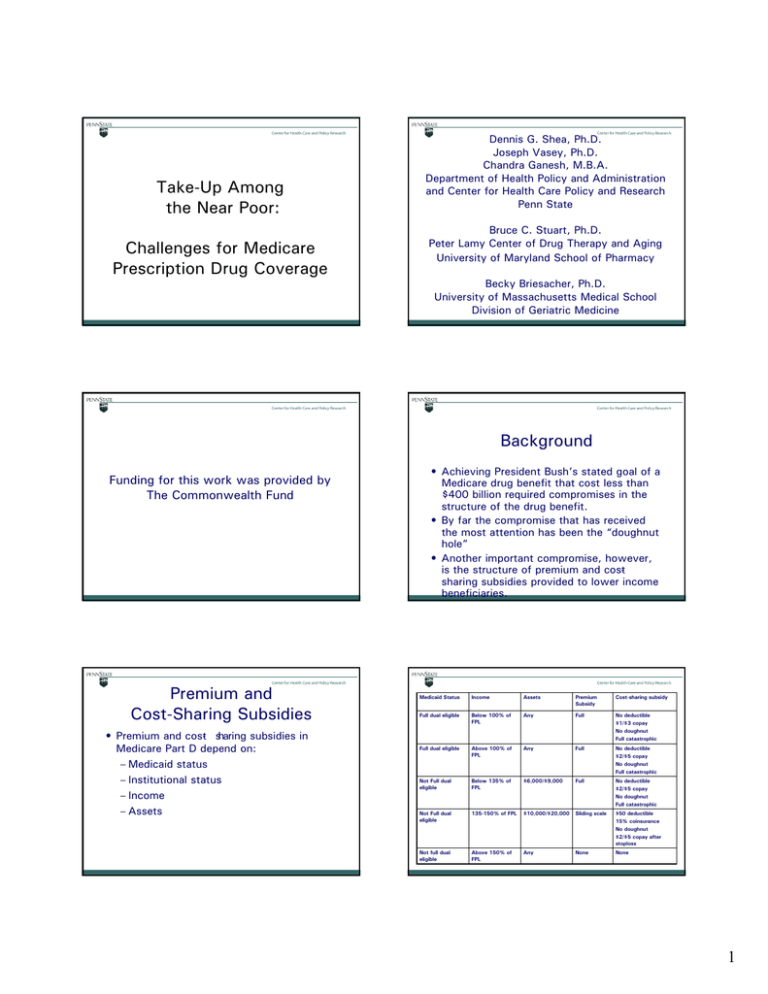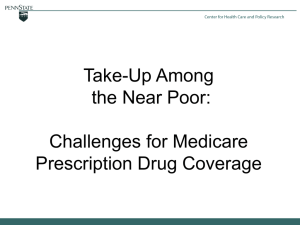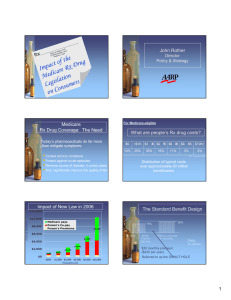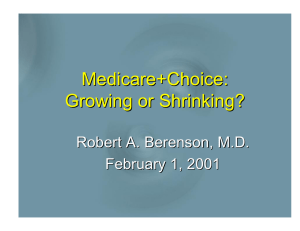Dennis G. Shea, Ph.D. Joseph Vasey, Ph.D. Chandra Ganesh, M.B.A.
advertisement

Take-Up Among the Near Poor: Challenges for Medicare Prescription Drug Coverage Dennis G. Shea, Ph.D. Joseph Vasey, Ph.D. Chandra Ganesh, M.B.A. Department of Health Policy and Administration and Center for Health Care Policy and Research Penn State Bruce C. Stuart, Ph.D. Peter Lamy Center of Drug Therapy and Aging University of Maryland School of Pharmacy Becky Briesacher, Ph.D. University of Massachusetts Medical School Division of Geriatric Medicine Background Funding for this work was provided by The Commonwealth Fund Premium and Cost-Sharing Subsidies • Premium and cost- sharing subsidies in Medicare Part D depend on: – Medicaid status – Institutional status – Income – Assets • Achieving President Bush’s stated goal of a Medicare drug benefit that cost less than $400 billion required compromises in the structure of the drug benefit. • By far the compromise that has received the most attention has been the “doughnut hole” • Another important compromise, however, is the structure of premium and costsharing subsidies provided to lower income beneficiaries. Medicaid Status Income Assets Premium Subsidy Cost-sharing subsidy Full dual eligible Below 100% of FPL Any Full No deductible $1/$3 copay No doughnut Full catastrophic Full dual eligible Above 100% of FPL Any Full No deductible $2/$5 copay No doughnut Full catastrophic Not Full dual eligible Below 135% of FPL $6,000/$9,000 Full No deductible $2/$5 copay No doughnut Full catastrophic Not Full dual eligible 135-150% of FPL $10,000/$20,000 Sliding scale $50 deductible 15% coinsurance No doughnut $2/$5 copay after stoploss Not full dual eligible Above 150% of FPL Any None None 1 Prescription Drugs and Lower Income Medicare Beneficiaries Policy Issue • Limitations and rapid phase - o ut of subsidies raise at least 2 important questions: – Will lower income Medicare beneficiaries enroll in Medicare Part D? – What effect will Medicare Part D have on the out- of- pocket costs of lower income Medicare beneficiaries? Elements of the Microsimulation • Over 10 million beneficiaries with incomes between $10,000 and $20,000 • Spend less in total on prescription drugs, but more out of pocket than those in other income groups • Less likely to have drug coverage and more likely to rely on Medicare+Choice and private plans when they do Estimating Take-Up • Baseline Data • Based on 1999 MCBS • Projected to 2006 population, income, and costs • Spending Module – Estimates effects of insurance on spending • Take - Up Module – Estimates decision to accept Medicare Part D coverage • Our Approach – Estimate net benefit of being in Medicare Part D plan – Enroll if (Third - party spending – current premium)Baseline < (Third - party spending + net risk premium– Medicare premium)Simulated Plan • Risk Premium Estimation • Medicare premium estimated as risk - adjusted premium based on enrolled population Estimating Spending Enrollment by Income Level • Our Approach – Estimate change in average coinsurance between old and new plan – Increase spending based on elasticity of –0.3 and estimated coinsurance change – Adjust spending for impact of doughnut hole and stop - loss – Allocate spending to Medicare, other third parties, and individual 80% 70% 60% 50% 40% 30% 20% 10% 0% Below100% 100-135% 135-150% 150-200% Over 200% Incom easaPercent of Poverty EnrolledinMedicarePart D 2 Enrollment by Income Level and Age Enrollment by Income Level and Health EnrolledinPartD EnrolledinPart D 80% 70% 60% 50% 40% 30% 20% 10% 0% 100% 80% 60% 40% 20% 0% Under45 45-64 65-69 70-74 75-79 80+ None Age 1 2 3 4or more Number of HealthConditions Below100% 100-135% 135-150% 150-200% Over 200% Total and Out-of-Pocket Spending by Income Below100% 100-135% 135-150% 150-200% Over 200% Reduction in Out-of-Pocket Drug Costs by Income 100% $4,000 $3,500 $3,000 $2,500 $2,000 $1,500 $1,000 $500 $0 80% 60% 40% 20% 0% Under 100% 100-135% 135-150% 150-200% Under 100% 100-135% 135-150% 150-200% Above 200% Incom easaPercent of PovertyLine Total Spending Above 200% Incom easaPercent of PovertyLine Out-of-Pocket Spending Mean Out-of-Pocket Drug and Premium Costs as a Percent of Income by Income and Health 10% Percent ReductioninOut-of-pocket Costs Marginal Impact of Subsidy Phaseout on Out-of-Pocket Costs $3,000 $2,500 8% $2,000 6% $1,500 4% $1,000 2% $500 0% $0 None 1 2 3 Num ber of HealthConditions 100-135% 135-150% 150-200% 4or m ore C hangeinIncom e C hangeinP rem iumandO utof-P ocket C osts Estimated for two persons at 130 and 155% of poverty with 4 or more health conditions 3 Lower Income Medicare Beneficiaries– Out on a LIMB? • Drug benefit does reasonably successful job at achieving universal coverage • Several potential hurdles for lower income Medicare beneficiaries – Enrollment dips = Welfare or entitlement? – Selection effects – Total and marginal costs in phaseout areas • Possible role for Medicaid and state h ti l i t l 4






